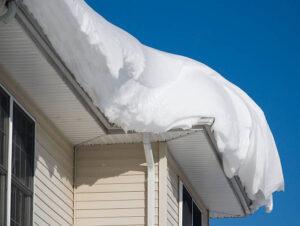
Every day, people rely on their roofs to protect them and their homes from harsh weather conditions. This is especially true during the colder winter months when inclement weather can strike at any moment. Winter is one of the hardest seasons on a roof, and snow and ice can have an impact on its longevity.
To keep your roof in good shape for years to come, its helps to understand how snow and ice can affect your roof’s structural integrity, as well as different roofing materials that are better able to withstand wintry weather, and how to prevent damage.
Common Impacts of Snow and Ice to a Roof
Snow and ice on your roof can be detrimental over the course of a single winter. Older roofs are particularly susceptible to winter weather, as decades of snow and ice storms can take a toll on their structural integrity. No matter the age of your roof or how it might look from below, it’s important to know how harsh winter conditions can affect your roof.
Stress
When something puts external pressure on a stationary object, the object experiences stress. If you’ve ever been outside shoveling snow and the shaft of the shovel has snapped in half, then you have an idea of how stress from snow and ice can affect your roof. The heavy downward force from snow accumulation is one of the most common impacts of snow on a roof.
Your roof can sag in areas of intense weight, causing water, snow and ice to build up even more. This heavy, isolated accumulation can lead to other issues such as leaks. In the worst-case scenario, your roof can even suffer a cave-in.
Ice Dams
Ice dams occur when the warm air seeping from the edges of your roof causes the snow near your gutters to melt. This melted snow then freezes, causing a barrier, or a dam, of ice to form around the edge of your roof. An ice dam can prevent water and snow from leaving your roof, leading to many issues that can cause damage.
If water and snow are unable to slide off your roof, the ice dam can hold back excess water which can eventually cause leaks. The water can also freeze and thaw multiple times in a row, leading to gutter damage or cause sections of gutter to disconnect from your roof altogether.
Leaks
Many people associate leaks with the rainy summer months, but the truth is that snow is actually a leading culprit in causing roof leaks. In addition to the stress that snow can put on your roof and ice dams, snow can also find its way beneath your shingles or work its way into small cracks in your roof.
These wintertime leaks can make damaged roofs worse, but the effects can reach even further. When the next sunny day rolls around, that snow can melt and get into your house. This water can soak insulation, walls and ceilings, which can lead to severe water damage and mold.
Freeze and Thaw
People in areas with cold winters understand how damaging the freeze and thaw cycle can be. Roads in the northern United States are prone to potholes every year, as water seeps into cracks in the asphalt. This water freezes during the winter and then expands, causing large holes in the road. The same principle applies to the impacts of ice on a roof.
If you have gaps in your shingles or small cracks anywhere on your roof, water could find its way inside. As the temperature drops in the winter, the water will expand as it freezes. The expansion can tear shingles from the roof and turn small cracks into larger ones.
How Do Snow and Ice Affect Different Roofing Materials?
How snow impacts your home’s roof depends on a few factors, such as its material. Here are some common roofing materials and their resistance to winter weather:
Copper: This durable roofing material has a life expectancy of 50 years or more. As a strong metal, it is resistant to mold, mildew and other water-related damages. It can also withstand inclement winter weather like hailstorms.
Clay: Clay tile roofing has been around for thousands of years, and for good reason. Although they are more typically associated with Mediterranean houses in warmer climates, they are actually very durable, and hold up well to the bitter cold of winter. And since it can trap air beneath its tiles, clay roofing acts as a natural insulator, keeping the warmth of your home inside. This can limit ice dam formation and damage done through the freeze and thaw cycle.
Slate: Slate roofs are an all-natural, durable roofing choice. As the shingles are pieces of thin rock, slate roofs are resistant to water damage and extreme temperature changes. They’re a natural insulator, keeping the warmth in your house and the cold outside. Care for them properly, and they can last up to 100 years.
Wood: If you like variety and sustainability, wood roofs are for you. There are many types of wood roofs to choose from, but one thing they all have in common is excellent insulation capabilities. They lack a strong resistance to water damage, but in drier climates, they’re a great energy-efficient option.
Preventing Damage From Snow and Ice
Proper maintenance is key to keeping your roof in good shape for years to come. Use the following three steps to help prevent future damage from snow and ice on your roof:
Replace: While some roofs may only need a small repair, other roofs could require a total replacement. It depends on your roof’s materials and the extent of the damage. If you’re considering replacing your roof, make sure you choose a material that will last and can withstand the winters in your area.
Clean: You should clean your roof at least twice a year to prevent damage. The best time to clean your roof is toward the end of fall and the beginning of spring. That way, you make sure nothing is on your roof by the time the snow and ice arrive, and you’ll have a clean roof once the warmer weather rolls around.
Inspect: Routinely inspect your roof to keep an eye out for areas of damage. If you have a leak, it may be difficult to find out exactly where it’s coming from. A professional roofing contractor, such as the team at GenSun, can inspect your roof and help you figure out the next steps.

